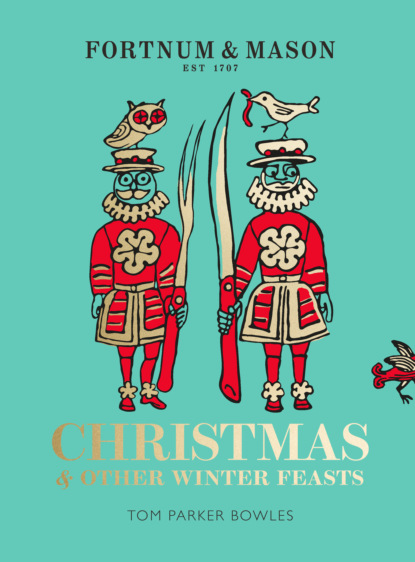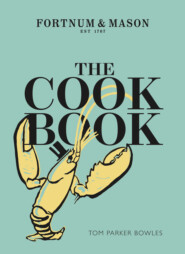По всем вопросам обращайтесь на: info@litportal.ru
(©) 2003-2024.
✖
Fortnum & Mason: Christmas & Other Winter Feasts
Настройки чтения
Размер шрифта
Высота строк
Поля
· 190g butter
FOR THE TOPPING
· 120g dark chocolate (55% cocoa solids), chopped
· 85ml double cream
· 50g honeycomb
Chop 50g of the chocolate into pea-size pieces and set aside. Chop the rest a little smaller and set that aside too. Sift the flour and cocoa powder into a bowl and set aside.
Put the eggs and sugar into a large bowl and beat with an electric mixer until pale and very thick. Melt the butter in a saucepan. When bubbles appear around the edge, remove the pan from the heat and stir in the 200g of chopped chocolate until melted. Fold this mixture into the eggs and sugar with a large metal spoon. Fold in the flour and cocoa powder in three additions, then finally fold in the remaining chopped chocolate.
Pour the mixture into a baking tin, roughly 23cm x 30cm, lined with baking parchment, and spread it out evenly. Place in an oven heated to 160°C/Gas Mark 3 for 15–20 minutes, until the edges are slightly risen but the mixture is still slightly soft in the centre (a skewer inserted in the middle should come out with a little mixture attached to it, but it shouldn’t be liquid). Remove from the oven and leave to cool.
For the topping, put the chopped chocolate into a bowl. Bring the cream to a simmer in a pan, then pour it over the chocolate and leave for a few seconds. Stir gently until smooth. If your honeycomb is in large pieces, put it into a plastic bag and bash gently with a rolling pin until you have small chunks. Spread the chocolate ganache over the brownie, then sprinkle on the honeycomb.
When the chocolate has set, cut the brownie into 18 squares or rectangles.
CARAMELISED BRAMLEY APPLE PANCAKES (#ulink_6569a437-7a69-5d8e-b852-e723cb0ed7cd)
The Bramley apple has a wonderful sharpness, which cuts a dashing swathe through all that caramel. These can be made in advance: simply prepare and fill the pancakes, then reheat in a moderate oven in a baking tin covered with foil.
& delicious with a glass of Fortnum’s aged brandy de Jerez, or a cup of finest Darjeeling tea
MAKES 8 PANCAKES, SERVING 4–8,
depending on appetite
· 4 Bramley apples, peeled, cored and cut into slices about 5mm thick
· 50g caster sugar
· 40g butter
· crème fraîche or whipped cream, to serve
FOR THE PANCAKES
· 100g plain flour
· 20g caster sugar
· a pinch of salt
· 2 large eggs
· 250ml milk
· 25g butter, melted
· a little vegetable oil, for greasing
First make the pancake batter. Put the flour, sugar and salt into a large mixing bowl and make a well in the centre. Crack the eggs into the well, then add a little of the milk and mix with a balloon whisk, gradually drawing the flour into the centre. Once all the flour has been incorporated into a smooth mixture, gradually whisk in the rest of the milk. Finally, whisk in the melted butter. Set the batter aside while you prepare the filling.
Heat a large, heavy-based frying pan and add the apple slices. Allow them to caramelise a little in the dry pan, turning them over from time to time. Add the sugar and cook over a medium heat, stirring occasionally, until it caramelises and the apples are golden brown. Add the butter, toss gently with the apples and cook for a few minutes longer.
To cook the pancakes, heat a 24cm pancake or frying pan over a moderate heat. Grease it by wiping it with a wad of kitchen paper dipped in oil. Ladle some batter into the hot pan, tilting the pan so the batter spreads in a thin, even layer. Quickly pour any excess batter into a jug (you can add this to the rest of the batter in the bowl while the pancake is cooking), then return the pan to the heat. Cook for about 30 seconds, until the pancake is golden underneath, then flip it over with a palette knife. Cook for another 30 seconds or so, until the second side is golden, then turn it out on to a warm plate. Make the remaining pancakes in the same way; you should have 8 in total.
Reheat the caramelised apples if necessary. Divide them between the pancakes, then fold the pancakes in half, and in half again. You can do this as you cook the pancakes, serving each one as it is ready, or cook all the pancakes, then fill them. Serve with crème fraîche or whipped cream.
The Shoot Lunch
We need to talk about pheasant. And grouse, partridge and snipe. Oh, and rabbit, hare and venison, too. Game, the furred and feathered stars of British seasonal food, the true nobles of our national larder, the envy of serious eaters across the globe. Low in fat, high in flavour, sustainable, and relatively cheap too. What’s not to adore?
Well, everything, according to the vast majority of Brits. Too visceral, they cry, and ‘difficult’, before blithely retreating to the bland indignities of the cheap chicken breast. So much safer, and less … well, threatening. Like offal, game is seen as something at the more hardcore, debauched end of British food. An ingredient that is best left to the adventurous. And I suppose one can see their point. Our taste buds have become so dulled over the years that anything with even a modicum of meaty might is treated with suspicion. The Victorians had a taste for ‘high’ game, meaning they hung the carcasses until the maggots started to drop off. And the flavour, as you might imagine, was a touch testing.
But that first taste of young grouse just after the Glorious 12th of August is as close to subtle perfection as any food on earth. Simply roasted (and to do anything else at this time of year is tantamount to heresy), you get that sweet, succulent flesh, scented with the merest whisper of heather. It’s about as far removed from the stinking flesh of popular imagination as Helen of Troy is from Medusa.
Then there’s the discreet charm of the partridge. Sadly, the native grey leg is a rare beast these days, supplanted by the farmed red leg or ‘Frenchie’. My father is convinced that the grey is far superior, in eating terms, to the red, with a deeper flavour and rather more depth. He knows of what he speaks. But the red leg is a fine bird, either roasted with unsmoked bacon draped across its breast, or transformed into a partridge pepper fry, where that delicate flesh is piqued by exotic spices.
Admittedly, pheasant can veer towards the dry, especially towards the end of the season. But it makes a fine stew, and the breasts, if cut off, can be breaded and turned into gamey goujons. Or even cured, over salt, as ham. Woodcock, with its molten brown eyes and rapier-like beak, is the most beautiful of birds. And its flavour is certainly a little more pronounced than that of its cousins. Oh, and some may not approve of the way it’s traditionally presented, the beak tucked under the wing, the head split open to reveal a tiny spoonful of winsome brain. A treat indeed. But one, perhaps, for the more seasoned game aficionado.
Still, who could resist the charms of rabbit in a punchy mustard sauce, or venison fillet, lightly seared. Hare is a magnificent beast, with the flavour going from majestic to downright fierce. These are not ‘extreme’ foods, but rather ingredients to be worshipped and adored. And Fortnum’s has long done a roaring trade in game, and also all manner of game consommés and pies (not least, the glorious Christmas Pye), plus the relishes we Brits consume with such, um, relish.
‘Every bird we sell is hung to perfection,’ cries a piece in a 1930s’ catalogue. ‘In fact we have arranged with the Duke not to so much as fire at a bird unless it has been properly hung. That’s how Fortnum’s do things.’ They have been and remain masters of the game pie – ‘Perhaps the finest things we do,’ according to the same catalogue. Francis Law, in A Man at Arms: Memoirs of Two World Wars, writes of the food in his officers’ mess: ‘expensive and superlative. Most of it came from Fortnum & Mason. Delicious pâtés and ham … salmon and game in season … such bounty was never to be seen again’. They plucked game, and even had a department that supplied game to the gentlemen’s club of St James’s, right up until the late 1940s. Occasionally, the supply would go the other way around, with Fortnum’s buying the game sent to the club by their members, and transforming it into pies and terrines.
Fortnum’s also had a whole department devoted to shooting, selling their own shotguns, and cartridges too. Plus all manner of caps, waxed jackets, plus-fours and picnics. They also maintain a tradition of catering for the shooting lunch, that claret-soaked happy hiatus where the morning’s sport is discussed and debated, over rich venison stews, shepherd’s pie, steak and kidney pudding, or even local fish and chips. My aim is not particularly true, but in the winter months, there are few places I’d rather be than in some rugged field, be it Dorset, Devon or Durham, with good friends, awaiting the flutter of wings. Far from being some bloodthirsty slaughter for ruddy-faced toffs, proper shooting is as much about conservation as it is about killing. And it goes without saying that every single bird killed is gutted, plucked and sent to the dealer. To be trussed, and sold on to those who crave their winged wonders. So abandon squeamish preconceptions, and embrace game. Start with a taste of partridge, and before you know it, you’ll be craving civet à la royale, and lusting after that woodcock. Ditch the dullard chicken breast, and, to quote a famous advert for American fags, Come to Where the Flavour Is.
GROUSE AND PEARL BARLEY BROTH (#ulink_2ec3fb21-d39d-5706-a6a5-12ba9666026b)
This is an old-fashioned recipe, no doubt about that. Not in terms of being stolid and dull, rather thanks to the clarification process. But do persevere, as the end result is a glimmering, topaz-hued broth with the most rich and deep of flavours.
SERVES 4
· 2 leftover grouse carcasses
· 2 litres good-quality chicken stock
· 500g chicken wings
· 1 large glass of brandy
· ½ a star anise
· 1 bay leaf
· a sprig of thyme






